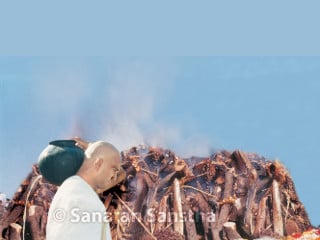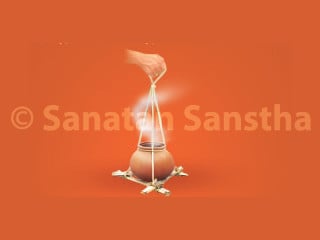To enable mankind to get closer to God through the medium of various events that occur from birth to death, Hindu Dharma has formulated various religious sanskārs. Among them, the post-death rite is the final sanskār. If post-death rites are performed with faith and as prescribed by our Scriptures, then the linga-dēha (subtle body) of the deceased person, without getting trapped in Bhulok (Earth region) or Martyalok (The region of the dead), acquires a positive momentum and moves on to higher regions. Consequently, the possibility of the deceased person tormenting the family members reduces. The possibility of such a linga-dēha being enslaved by negative energies reduces too.
Once a person dies, his/her post-death rites are to be performed at the hands of a priest as mentioned in the Scriptures. Finding a priest with the knowledge of post-death rites is difficult in most places. What should be done under such circumstances is given ahead. There could be a difference in some of the acts, depending on the region or traditions. Wherever one finds such a difference one can consult one’s priest.
1. Initial rites
A. Collecting the required material for the rite
Given ahead is a list of such material :
- Bamboo
- Coir rope (1 kilogram)
- Two pitchers (earthen pots) – one small and other large
- A white cloth sufficient to cover the dead body
- Garland of tulsī (Holy basil) leaves
- Mud from the base of a tulsī plant
- 250 grams black sesame
- 500 grams ghee (Clarified butter)
- Darbha (A kind of sacrificial grass)
- 100 grams camphor
- One match-box
- Seven balls made from wet barley or rice flour
- Palīpanchapatra (An offering spoon and a metal cup used in ritualistic worship)
- Wooden logs of mango or jackfruit tree
- A sickle
- Bhasma or vibhutī (Holy ash)
- Gopīchandan (This is a kind of white mud found in the Holy place of Dvarka)
- A piece of sandalwood
- Cowdung cakes
- One bowlful of panchagavya (a mixture of cow’s milk, curd, ghee, cow’s urine and cow dung)
- Seven pieces of gold.
B. The eldest son of the deceased person is authorised to perform all the rites beginning from kindling the fire of the funeral pyre till the completion of entire rites. If due to some unavoidable circumstances the eldest son is unable to perform the rites, then the youngest son takes his place. If he too is not available, then anyone among the other sons, son-in-law or other relatives can perform the rites, in that order. The person who performs the rite is called the ‘kartā’. The rites for an unmarried male/female, or a person without any issue can be performed by the younger (immediate) brother, father or elder brother or other relatives, in that order.
C. Once a person is dead, as far as possible his/her upper and lower limbs and neck should be straightened immediately and his eyes closed. With passage of time, doing this becomes difficult.
D. Do not resort to crying aloud, beating the chest etc.
E. The household members should pray intermittently to Deity Dattātrēya for protection of the subtle-body of the deceased from the attacks of negative energies thus -‘O Dattātrēya, let your protective sheath be present around the linga-dēha of … (mention the name of the deceased) always. We pray unto your Holy feet to impart progressively higher momentum to the deceased.’
Perform all subsequent rites accompanied while chanting ‘Shrī Gurudēv Datta’.
F. Before placing the dead body on the floor, smear the floor with cowdung. If it is not possible to smear it with cowdung, then sprinkle water containing either cowdung or vibhutī on the floor. Spread darbha on the floor and place on the darbha either a grass-mat, blanket, rug or a woolen blanket, and on it lay the person in a south-north direction with his/her feet facing the south.
Sprinkle bhasma or vibhutī around the body in an anti-clockwise direction at some distance from the body.
G. If Gangājal (Water from the holy river of Gangā) has not been put in the mouth of the person before death, then pour some Gangājal in his/her mouth and place a tulsī leaf on it. Similarly, close the orifices of the nose and ears by placing a bunch of tulsī leaves in them.
H. Light an earthen lamp or samaī (A metal lamp on a pedestal) with a single wick and place it on a mound of wet kneaded flour of wheat at some distance from the head of the dead body. The flame of the lamp should be facing the south direction. Even when the dead body is removed from there, keep the lamp lit for the next ten days.
I. The kartā should shave his head. The beard and mustache should also be shaved off and nails clipped. While the head is being shaved, retain a tuft of hair (Perform Kshourkarma), instead of a round area of hair as kept by a batū (One whose thread ceremony has been performed).
Brothers of the kartā and family members who are younger to the deceased should also shave their heads. If that is not possible, then it should be done on the 10th day.
If the kartā is elder to the deceased, then he should not shave his head. Do not shave the head after sunset, since that is prohibited. Under such circumstances, the kartā should shave the head on the day on which the uttar-kriyā (Follow-up rites of daily pinḍadān and offering of tilānjali is to begin). The rest of the family members should shave their heads on the 10th day. Women should not cut their hair or nails.
J. The kartā should bathe and use new fabric to cover himself; for example – wearing a dhoti. Do not wear an uparna (A shawl or a small single cloth worn loosely over the shoulders).
K. Family members younger to the deceased, and other relatives should pay their obeisance to the dead body.
L. The dead body should then be taken to the front yard of the house and placed in an east-west direction with the feet facing the west. The kartā should then bathe the corpse amidst loud chanting of Deity Dattātrēya’s Name – ‘Shrī Gurudēv Datta’.
Note – A custom of everyone offering a garland of flowers to the dead body, putting sugar in the mouth and applying kumkum (saffron) to the forehead is prevalent in many places. From the perspective of spiritual science, all this is inappropriate.
M. After the bath, drape the dead body with new clothes (such as dhoti-shirt or a sari). These clothes should be purified by sprinkling cow’s urine or tīrtha (sacred liquid) or by holding them over smoke of frankincense.
-
If a virgin / unmarried woman has died, she should be dressed in a sari of any colour except white.
-
If a married woman has died, she should be dressed in a new green sari, green bangles should be put on her wrist and a garland of flowers should be put in her hair. Kumkum should be put across her forehead. Other married women should apply haldī (turmeric) and kumkum to the dead married woman.
N. Place the dead body on a mat or a mattress. Cover the entire body (except the feet) with one single plain white cloth. Leave the feet uncovered. Tear off a portion of the cloth that is covering the face and expose the face. A portion of the cloth near the leg (one fourth the length of total cloth) is cut and used by the kartā as uparna till the twelfth day. This cloth should not be misplaced. It should be placed near the pinḍas (rice balls) during the ritual of sapinḍikaraṇ on the 12th day and be immersed in water along with the pinḍas.
O. When the husband dies, the wife should separate the muhurtamaṇī and the black beads that are woven in a golden string and offer them to be kept along with the dead body of her husband on the pyre. Other gold in the mangalasutra and gold ornaments should be taken off and kept safely.
P. Do not keep the dead body for long. If for any reason it is required to be kept, make a circle of Name-strips of Deity Dattātrēya around the dead body. Similarly, continue to play bhajans sung by Saints or chants of Deity Dattātrēya’s Name in the house. Those present should also continuously chant ‘Shrī Gurudēv Datta’.
Q. As far as possible, cremate the dead body during the day time.
R. All family members should constantly chant ‘Shrī Gurudēv Datta’ till the 13th day. Combine this chanting with praying as mentioned in ‘Point E’.
S. No one should unnecessarily touch the dead body.
T. If a boy or a girl aged less than 3 years old dies, they are buried, and no religious rites are performed for them.
2. Preparation for the cremation ritual
A. Tying a bier
-
Use bamboo sticks for making strips for the bier, as well as for placing the pot containing fire.
-
For preparing a bier, cut two pieces of bamboo approximately 6 feet in length and place them horizontally on the ground. Keeping a space of one & a half feet between them, tie the bamboo strips to them leaving equal space. While tying the strips, do not cut the extra portion of the coir rope, as that is later used for tying the dead body when it is placed on the bier.
-
Prepare three strips of bamboo by cutting it vertically. Tie them together in a triangular shape so that the pot of fire fits on it correctly.
-
Once the bier is ready, place it in the front yard in an east-west direction.
B. Once all the rituals that are to be carried out on the deceased inside the house are over, the dead body is brought out and laid on the bier with its head facing the east and legs facing the west.
C. Tie the big toes of both the feet together.
D. The dead body is tied to the bier with the help of coir ropes at the sides of the bier.
E. The clothes and bed-sheets of the deceased should be carried with the deceased during the funeral. Then these items should be placed on the pyre.
3. Funeral procession
A. The kartā should lead the funeral procession. He should hold a pot containing the ignited fire in his right hand.
B. The family members and relatives of the deceased, or in case they are absent, the neighbours should lift the bier and start walking behind the kartā. Four people should shoulder the bier. Nobody should stand between the kartā and the bier. All people in the procession should walk behind the bier.
C. The dead body should be carried with its head in front during the funeral procession.
D. All should chant aloud ‘Shrī Gurudēv Datta’ till they reach the crematorium.
E. When the funeral is half way through or when it reaches the entrance of the crematorium, the bier is lowered and placed on the ground. The kartā then places the objects in his hand on the ground and offers two pinḍas of barley/rice flour. These pinḍas may be brought from the house. Water is poured into a pot and black sesame are added to it. The pinḍas are then placed on darbhas to the right and left side of the dead body. Water mixed with sesame (til) is offered to the pinḍa on the right side through the pitru-tīrtha on the palm (Area of the palm between the thumb and the index finger) while reciting the mantra – ‘श्यामाय अयं पिण् ड उपतिष्ठतु ।’.
Thereafter, water mixed with sesame is also offered to the pinḍa on the left side while reciting the mantra ‘शबलाय अयं पिण्ड उपतिष्ठतु ।’.
F. Then, people who had shouldered the rear of the bier exchange their positions with those in the front, the bier is lifted and the funeral procession moves ahead.
4. Placing the dead body on the pyre
A. After reaching the crematorium, the dead body is placed on the pyre along with the bier, with its feet facing the north and head facing the south direction.
B. All the coir strings and bamboos of the bier are untied, but placed on the pyre itself.
C. Big toes of the dead body are untied.
5. Rituals before kindling the pyre
A. Pieces of gold are placed on the mouth, both the nostrils, ears and eyes. If it is not possible to place the pieces of gold, drops of ghee can be put with the tip of a darbha or with the help of a tulsī leaf.
B. The kartā then should place the pot for fire in the north-west direction and kindle the fire in it. While reciting the mantra ‘क्रव्यादनामानमग्निंप्रतिष्ठापयामि ।’ (Meaning : ‘I am establishing a fire by the name of Kravyād’), black sesame seeds should be offered to the fire. (Some people prepare a triangular altar of mud to the north-west side of the dead body and kindle the fire taken from the pot). Then, oblations of ghee are offered to the fire as mentioned ahead. The word ‘स्वाहा’ (swāhā) is uttered with each mantra while offering each oblation, and at the end of the sentence, ‘इदं न मम ।’ (This does not belong to me) is uttered.
अग्नये स्वाहा । अग्नय इदं न मम ।।
कामाय स्वाहा । कामाय इदं न मम ।।
लोकाय स्वाहा । लोकाय इदं न मम ।।
अनुमतये स्वाहा । अनुमतय इदं न मम ।।
Then, reciting the mantra -‘ॐ अस्माद्वैत्वमजायथा-अयंत्वदभिजायतां । असौ .. (mention the name of the deceased) प्रेताय स्वर्गाय लोकाय स्वाहा ।’, one oblation is offered on the chest of the dead body and after taking the name of the deceased, the following sentence is uttered – प्रेताय इदं न मम ।।’
C. Five balls of the size of a betel nut prepared from either barley or rice flour are placed on the forehead, face, both the shoulders and on the chest of the dead body. Ghee is then poured on each of these balls.
6. The ritual of cremation
A. Those in attendance should place a piece of sandalwood, any other wood, incense sticks or camphor on the dead body. This is not mentioned in the Scriptures, but is a general custom.
B. The kartā should kindle the pyre with the Agnī (Fire) brought in the pot. Begin with head side of the dead body for a male or from the feet side for a female, and kindle the pyre from all the sides moving in an anti-clockwise direction. This can be done by first igniting a piece of dried coconut leaf on the fire that has been brought in the pot and using it to kindle the pyre.
C. Do not use objects such as tires to light a pyre. Make minimal use of kerosene or other inflammable substances, and that too, if it is absolutely necessary.
D. As far as possible, avoid the contact of smoke emanating from the pyre.
E. Once the skull of the dead body bursts, as judged by its sound, the kartā should stand towards the feet of the deceased facing the south direction while holding the earthen pot filled with water on the shoulder. Someone should stand behind the kartā and make a hole in the pot just below its neck with a stone picked up from the crematorium itself. This stone is known as ‘ashma’. The kartā then circumambulates around the dead body once in an anti-clockwise direction, while the water keeps flowing around the pyre through the hole. On completion, a second hole is made in the pot below the first hole by the person using the same ashma. The kartā then completes the second circumambulation like the first one. Similarly, a third hole is made, which is followed by the third circumambulation. On completion of the third circumambulation, the kartā stands towards the head of the deceased with his back towards the pyre in case of a male and towards the legs of the deceased with his back towards the pyre in case of a female. Thereafter, he throws the pot backwards so as to break it without looking back. In the present times, this act is performed immediately after kindling the pyre.
F. The kartā should safely bring home the ashma that was used for making the holes in the pot.
Reference : Sanatan’s Holy Text, ‘Death and post-death rites’


 Rituals to be performed after cremation till the 13th day after death
Rituals to be performed after cremation till the 13th day after death In which direction should the dead body be placed before taking it to the crematorium ?
In which direction should the dead body be placed before taking it to the crematorium ? Rituals after death as per Hinduism
Rituals after death as per Hinduism